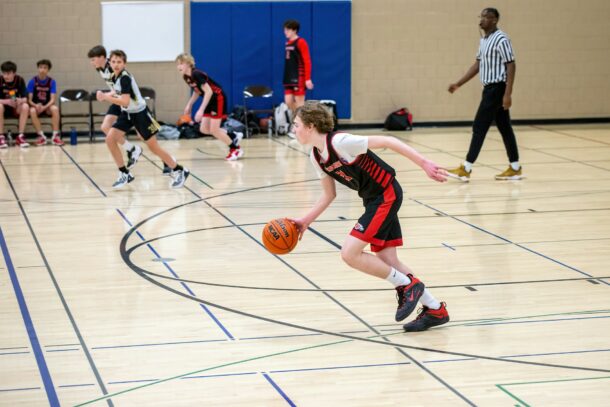NBA-ing High School Basketball, Hurrying-up the Game via Mandatory Shot-Clock
by 4159987 | Jul 11, 2017 | Uncategorized
NBA-ing High School Hoops,
Hurrying-up the Game via Mandatory Shot-Clock
Since the inception of ESPN, much of basketball has become gimmick & hype. In part this is because ESPN now must fill 5 television channels, different-language magazines, and global radio talk shows with “content.” Daily a cache of cliches are offered up by recent-retired players and fired coaches, who serve as “analysts” and “commentators.” As a result, it is painful to watch/listen to ESPN, which is why the network is steadily losing money.
ESPN-speak now includes “one and done,” and novel approaches like “positionless ball,” and new names for old positions, like “stretch-4,” and (my favorite), being an “over and under guard, who can do it all” (whatever that means).
Not only has ESPN changed how we as basketball coaches speak, it has, rightly or wrongly, tied its success to the worldwide promotion of professional sports. The strategy is simple: as ESPN promotes them, they in turn carry ESPN. This is why ESPN is on a warpath to drive-down NBA-style basketball into every USA college and university, and now rural and urban high school. This “NBA-ing” of basketball has resulted in Elite & AAU tournaments replacing nearly all recruiting of players from high school games. Every guard in every US college and high school now wants to “play between the arches” (to quote ESPN), like Steph Curry. No player now wants to turn his back to the basket and play post. Zero players believe they can build their basketball careers by excelling at defense. Who wants to pass when I can dribble on my own?
The latest move to NBA-change high school basketball is (no surprise) supported by the majority of talking heads on ESPN. It is to make teenage boys run faster and shoot quicker from farther away, so that those in the stands do not get bored. The way to make 15 year olds run faster is to impose on them an NBA-like shot clock.
Let us be clear. Imposing a shot clock in high school has nothing to do with helping young players learn or execute the complex game of basketball. It has nothing to do with helping kids. In fact, kids be damned. This is about us! It is about excitement, offense, shooting, 3s! In the process, our making kids sprint faster, pass less, do less post work, and launching even more 3s, will result in nothing more than a rocket launch fest.
This is the worst way to improve the quality of high school play, and worse, coaching. If high school basketball is really, really all about helping kids, and developing young players (isnt that what we all say?), this stupid, short sighted move shows now our hypocrisy as nothing before.
While making kids run faster may titilate the analyst in all of us, it will decrease good shots taken, eliminate offensive rebounds, and lead in the end to a very boring style of play. It will also mean, also in line with NBA-ing of hoops, less defense, less team play, less traveling calls, more dribble drives via isolation plays, and more players standing around between the arches watching fellow teammates build up point totals.
To show the insanity that now surrounds this phantom issue of a shot clock, consider the fervor generated by a non-high school basketball coach in Australia, who hosts the facebook page “Basketball for Coaches.” Trevor McLean (a/k/a Coach Mac), admits he is a youth basketball coach with less than 10-years experience. He has never coached any team in USA, and never coached a high school team, even in his beloved country down under. And yet, on his facebook page with 79,000 followers he posts sensationalistic articles like, “Why High Schools Must Adopt Shooting Clocks.” He does so every 2 months or so, I think because each time it generates 300-700 replies. But ask yourself: WHY does a person 9429 miles away from America, who has never coached here, or in ANY high school, care what high school players, coaches and fans do in, say, Altoona, WI, or Murfreesboro, TN? It would be no different than if Russians tried to tell kids in Tasmania, Australia how they should play Cricket. And yet, Mac waxes eloquent.
This, really, is the key to this whole non-issue. The truth is this: a high school shot clock solves no real problem in high school basketball. If high school games take too long, then more-easy fixes are to reduce the number of time-out teams can call, or create stiffer penalties on intentional garbage fouls in the last, say, 2 minutes of a game. Or, better yet, eliminate any and all media-related timeouts.
There are no actual evils in HS ball than a shot clock will cure. There is no damsel it will rescue. Secretly, I believe it is coming about because analysts want higher point scores in games. So while coaches talk defense, analysts cry “3s!” Such crying will not quiet till games end 140-135.
Do you remember Rade from the movie “Hoosiers?” His basketball-ignorant dad & cadre of analyst-buds yelled to him “Shoot!” while his coach tried desperately (on way to state championship) to build a team. With the shot clock in place, now ALL the arena will shout “Shoot!” while the coach can do nothing but watch.
The RULES The person running the clock will need to know…
Become a Better Coach. Check out Teachhoops.com
Terry Boesch is a teacher in Martinsville, IN (home of John Wooden), and also coaches girls basketball. Feel free to email him at [email protected], or call/text at 317.643-6042


